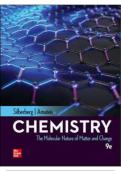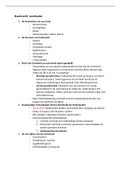,CHAPTER 1 KEYS TO THE STUDY OF
CHEMISTRY
FOLLOW–UP PROBLEMS
1.1A Plan: The real question is “Does the substance change composition or just change form?” A change in
composition is a chemical change while a change in form is a physical change.
Solution:
The figure on the left shows red atoms and molecules composed of one red atom and one blue atom. The figure on
the right shows a change to blue atoms and molecules containing two red atoms. The change is chemical since the
substances themselves have changed in composition.
1.1B Plan: The real question is “Does the substance change composition or just change form?” A change in
composition is a chemical change while a change in form is a physical change.
Solution:
The figure on the left shows red atoms that are close together, in the solid state. The figure on the right shows red
atoms that are far apart from each other, in the gaseous state. The change is physical since the substances
themselves have not changed in composition.
1.2A Plan: The real question is “Does the substance change composition or just change form?” A change in
composition is a chemical change while a change in form is a physical change.
Solution:
a) Both the solid and the vapor are iodine, so this must be a physical change.
b) The burning of the gasoline fumes produces energy and products that are different gases. This is a chemical
change.
c) The scab forms due to a chemical change.
1.2B Plan: The real question is “Does the substance change composition or just change form?” A change in
composition is a chemical change while a change in form is a physical change.
Solution:
a) Clouds form when gaseous water (water vapor) changes to droplets of liquid water. This is a physical change.
b) When old milk sours, the compounds in milk undergo a reaction to become different compounds (as indicated
by a change in the smell, the taste, the texture, and the consistency of the milk). This is a chemical change.
c) Both the solid and the liquid are butter, so this must be a physical change.
1.3A Plan: We need to find the amount of time it takes for the professor to walk 10,500 m. We know how many miles
she can walk in 15 min (her speed), so we can convert the distance the professor walks to miles and use her speed
to calculate the amount of time it will take to walk 10,500 m.
Solution:
Time (min) = 10,500 m
= 97.8869 = 98 min
Road map:
Distance (m)
1000 m = 1 km
Distance (km)
Copyright McGraw-Hill Education. This is proprietary material solely for authorized instructor use. Not authorized for sale or distribution in
any manner. This document may not be copied, scanned, duplicated, forwarded, distributed, or posted on a website, in whole or part.
1-1
, 1.609 km = 1 mi
Distance (mi)
1 mi = 15 min
Time (min)
1.3B Plan: We need to find the number of virus particles that can line up side by side in a 1 inch distance. We know the
diameter of a virus in nm units. If we convert the 1 inch distance to nm, we can use the diameter of the virus to
calculate the number of virus particles we can line up over a 1 inch distance.
Solution:
7
No. of virus particles = 1.0 in
5 5
= 8.4667 × 10 = 8.5 × 10 virus particles
Road map:
Length (in)
1 in = 2.54 cm
Length (cm)
7
1 cm = 1 × 10 nm
Length (nm)
30 nm = 1 particle
No. of particles
1.4A Plan: The diameter in nm is used to obtain the radius in nm, which is converted to the radius in dm. The volume of
3
the ribosome in dm is then determined using the equation for the volume of a sphere given in the problem. This
volume may then be converted to vo
Solution:
Radius (dm) =
diameter
= 1 m 1 dm = 1.07 × 10–7 dm
21.4 nm
2 2 110 9 nm
0.1 m
4 3 4
3.141591.07107 dm = 5.13145 × 10–21 = 5.13 × 10–21 dm3
3 3
Volume (dm ) =
3 3
1 L 1
Volume ( L) = 5.131451021 dm 3 = 5.13145 × 10 = 5.13 × 10 L
–15 –15
(1 dm)3 106 L
Copyright McGraw-Hill Education. This is proprietary material solely for authorized instructor use. Not authorized for sale or distribution in
any manner. This document may not be copied, scanned, duplicated, forwarded, distributed, or posted on a website, in whole or part.
1-2
, Road map:
Diameter (dm)
diameter = 2r
Radius (dm)
3
V r
3
Volume (dm )
3
1 dm = 1 L
6
1 L = 10
3
1.4B Plan: We need to convert gallon units to liter units. If we first convert gallons to dm , we can then convert to L.
Solution:
3
Volume (L) = 8400 gal 3
= 31,794 = 32,000 L
Road map:
Volume (gal)
3
1 gal = 3.785 dm
3
Volume (dm )
3
1 dm = 1 L
Volume (L)
1.5A Plan: The time is given in hours and the rate of delivery is in drops per second. Conversions relating hours to
seconds are needed. This will give the total number of drops, which may be combined with their mass to get the
total mass. The mg of drops will then be changed to kilograms.
Solution:
60 min
60 s 1.5 drops 65 mg 10 g
3
1 kg
Mass (kg) = 8.0 h 3 = 2.808 = 2.8 kg
1 h 1 min 1 s 1 drop 1 mg 10 g
Road map:
Time (hr)
1 hr = 60 min
Time (min)
1 min = 60 s
Copyright McGraw-Hill Education. This is proprietary material solely for authorized instructor use. Not authorized for sale or distribution in
any manner. This document may not be copied, scanned, duplicated, forwarded, distributed, or posted on a website, in whole or part.
1-3





